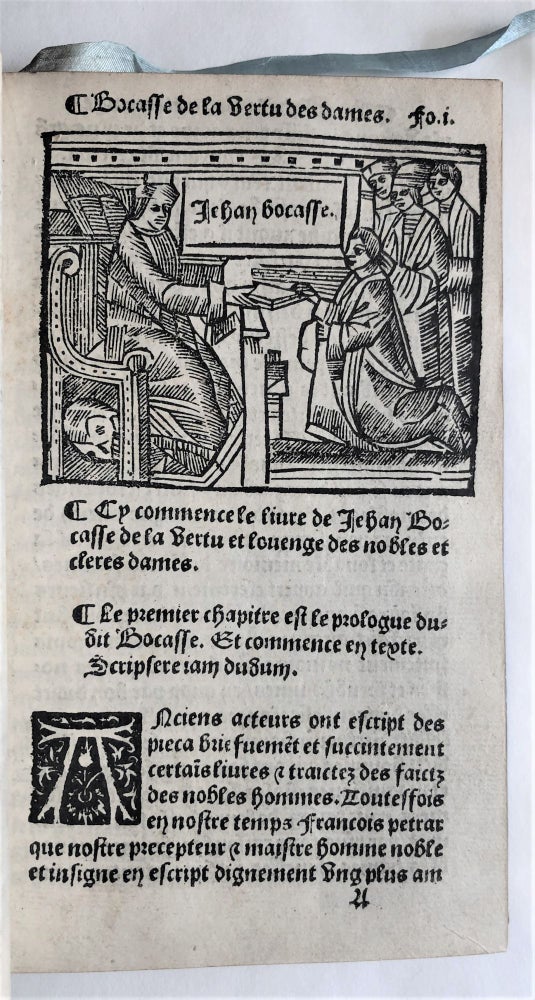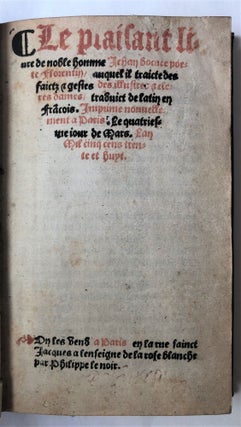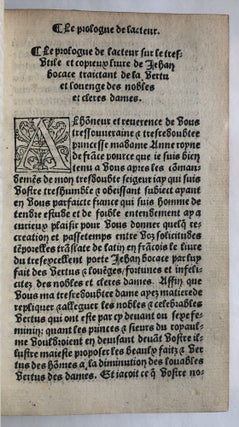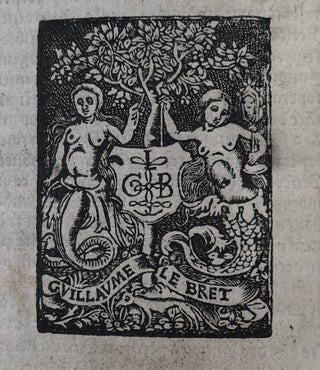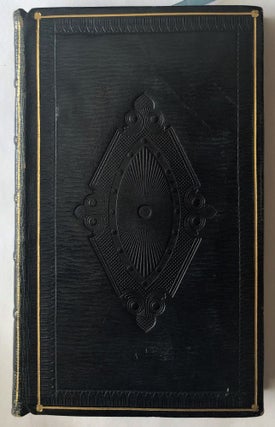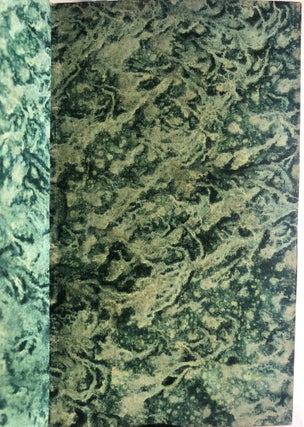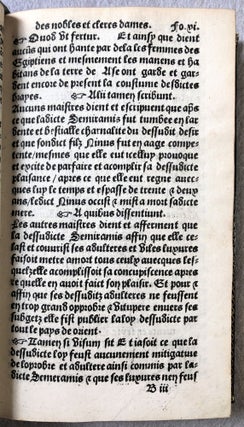Le plaisant livre de noble homme Jehan Bocace poete florentin, auquel il traicte des faictz & gestes des illustres & celebres dames. Paris: [Jean Réal for] Philippe Le Noir, [Guillaume Le Bret, and others], 1538.
8vo (144 x 85 mm). [8], 196 leaves. Title printed in red and black, bâtarde type, small typographic manicules (pointing hands) used throughout. Half-page woodcut of an author presenting his book to a seated dignitary, with reserved space for letterpress name, here “Jehan bocasse”; a variety of metalcut floriated initials, final verso with woodcut device of Guillaume Le Bret (Renouard 588). Title with old repair at top slightly affecting 2 letters, a couple of tiny holes, worming in or near gutters catching a few letters in quires R-T, skillful discreet repairs in ff. CC3-6, small stain in quire M. Nineteenth-century French blue straight-grained morocco (ca. 1820), covers with gilt rule border enclosing blind roll-tooled neoclassical frame and central blind-stamped lozenge, spine gold-tooled and lettered, board edges gold-tooled, gilt edges, green patterned pastepaper endleaves (corners very lightly bumped, else fine). A few old effaced inscriptions.
An attractive copy of the second edition of De mulieribus claris in French, using the text of Antoine Vérard’s edition of 1493. Although Vérard had tried to pass the translation off as his own, it was in fact a slightly revised version of an anonymous French translation made ca. 1401. Vérard’s editions of Boccaccio in French had made the writer more accessible to a French public, but it was not until the sixteenth century that his works became more widely known, and frequently imitated. This was the “golden age” for Boccaccio in France, which would draw to a close with the restrictions placed by the Church on the racier passages of the Decameron.
On Famous Women was the first biographical survey devoted exclusively to women in (Western) literature. But, in spite of the plethora of surviving Latin manuscripts of the text, Boccaccio’s survey of 106 women of distinction (some for their vices), drawn from the Bible, mythology, history, and from amongst Boccaccio’s contemporaries, was of less interest to sixteenth-century French readers than Griseldis, Fiametta, or indeed the Decameron. Forty-five years had passed since the appearance of the first printed edition in French before a group of Paris publisher-booksellers decided to publish the work anew. In order either to blanket the market, to obviate pirate editions, or to spread the risk, no fewer than thirteen booksellers shared this pocket-sized edition. The first and last quires, containing the titles, colophons and publishers’ devices, appear to have been reset for the various issues (cf. Hortis’s transcriptions). The present copy bears the imprint of Philippe Le Noir and the woodcut device of Guillaume Le Bret. The printer was recently identified as Jean Réal, whose metalcut capital initials are used at the head of each chapter. This was the first book from his press.
The typographic manicules in the text were added by the printer as a finding aid, to signal the Latin articulating phrases left in by the translator (the Latin phrases appear also in Vérard’s edition, but without any specific typographic mark highlighting them).
Two US copies located, at Princeton and Smith College. Moreau V, 742; BM / STC, p. 71; Brunet I, 990-91; Bechtel B-224; Hortis, Studi sulle Opere Latine del Boccaccio (1879), pp. 798-800. Cf. BnF, Boccace en France (1975), 123.
No longer available

